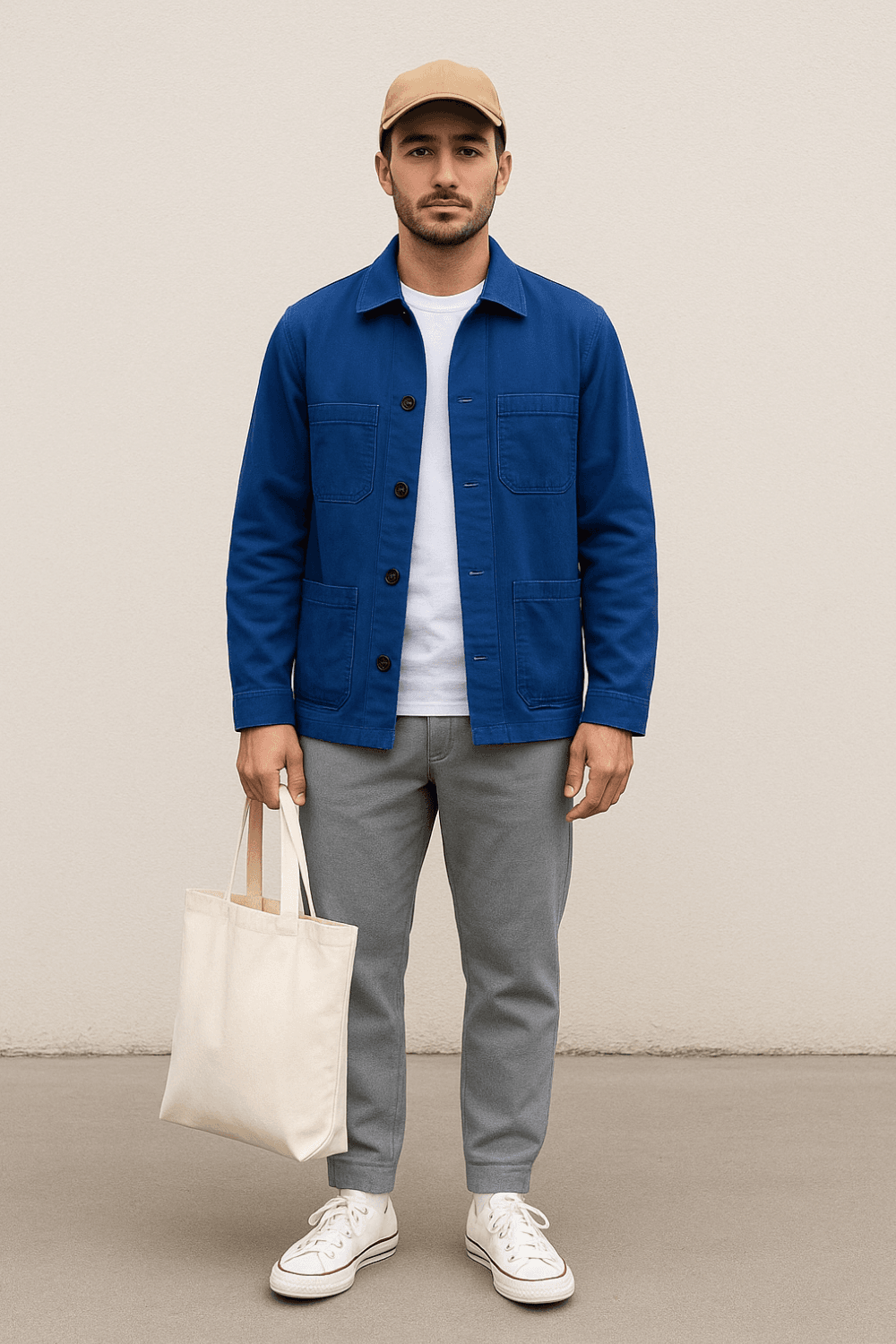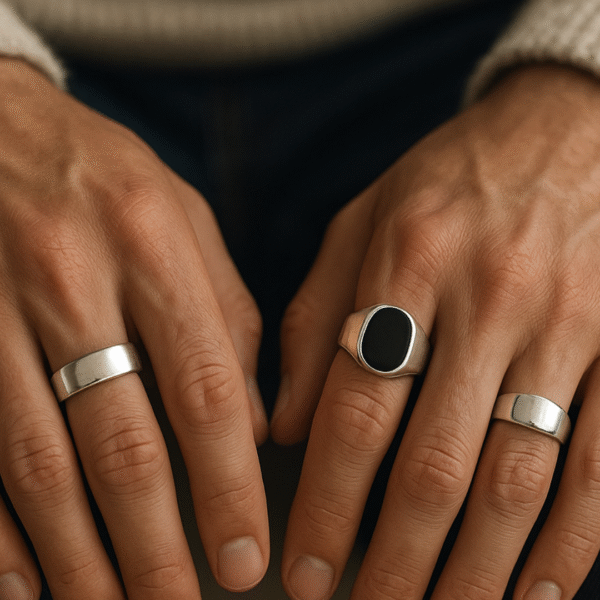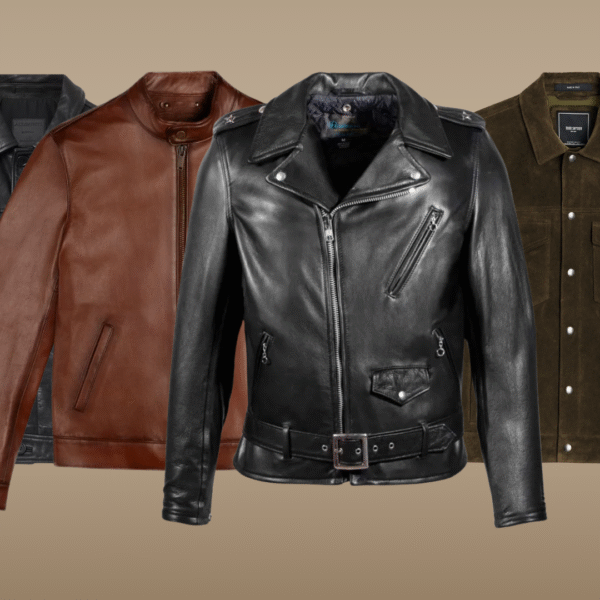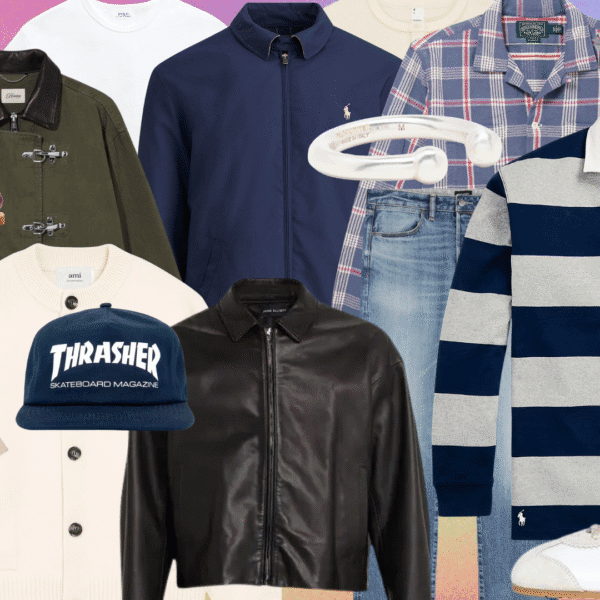The Complete Guide to Men’s Chore Coats (2025)

This is a comprehensive guide to men’s chore coats.
In this guide, we’ll cover:
- What the chore coats are
- How to style a chore coat for different settings and seasons
- Styling mistakes to avoid
- When NOT to Wear a Chore Coat
- Washing Instructions by Fabric Type
- Storage and Daily Care
- Some commonly asked questions
What Is a Chore Coat?
The chore coat is a type of workwear jacket.
It was originally made for French laborers in the late 19th century, and later was adopted by American workers, especially by railroad men, farmers, and factory workers, because they needed something tough that could hold tools and withstand the daily grind.
After nearly two centuries of evolution, chore coats have moved from workshops into modern wardrobes.
Now they’re one of the most versatile men’s jackets for casual and smart casual occasions.
What Makes a Good Chore Coat?
Chore coats have very specific features that makes them unique and they can be a good indicator when you buying a chore coat.
Key Design Elements
Even after nearly two centuries, some key features of chore coats haven’t changed, because that’s what makes them unique and versatile.
- Patch Pockets: The most iconic chore coat feature. Traditionally, two prominent patch pockets at the hip and one or two on the chest
- Button-front closure: While a chore coat can have a zipper, especially in modern designs, it’s not typical. Classic versions are almost always button-front
- Collar: A classic chore coat typically has a simple, pointed shirt-style collar
- Straight, boxy fit: Chore coats have a slightly boxy shape because of their workwear design. They don’t hug the body
Essential Materials
Chore coats are originally made from sturdy fabrics like cotton canvas (also called cotton duck) or denim.
Why?
Because of their workwear design, the materials have to be:
First of all, tough. Understandable, right?
Second of all, stiff and keep the boxy shape.
Third of all, easy to care. Easy to wash and hard to stain.
Today, you’ll find more fabric options alongside these originals.
Here are some of the most common ones to consider when buying a chore coat.
- Cotton Duck Canvas: The original. It’s stiff but gets soft over time. Brands like Carhartt are famous for this
- Denim: A classic American workwear fabric. A denim chore coat will age like your favorite pair of jeans. Indigo or black ones are classic choices
- Cotton Twill/Moleskin: Softer than cotton duck canvas. Great for transitional seasons and smart casual looks
- Corduroy or Wool: Great for fall and winter. They are more textured and warmer than standard cotton
Fit Considerations
This is where most of the problems occur. Let’s fix them.
- Shoulders: The shoulder seam should be exactly at the edge of the shoulder, or slightly off
- Sleeves: Should hit right at your wrist bone. This isn’t a dress shirt. You don’t want cuffs showing underneath
- Length: A chore coat should hit between your waistband and mid-thigh. It should be long enough to cover your waistband, even when you raise your arms
- Body: A chore coat cannot be too tight. You should be able to wear a sweater underneath when buttoned
5 Proven Ways to Style a Chore Coat
Here are five ways to style a chore coat.
I’ll break down specific outfit combinations that work, organized by occasion and vibe.
Style #1: The Heritage Workwear Look
First of all, let’s create a classic look that honors the coat’s roots.
The Chore Coat: Go for a classic fabric like duck canvas or raw denim in traditional “bleu de travail” (French work blue), brown, or navy.
Inner Layer: Keep it simple. A plaid flannel shirt, a chambray work shirt, or a thick cotton henley are all perfect choices.
Pants: A pair of raw or selvedge jeans looks the best. Or go for work pants from brands like Dickies or Stan Ray in khaki or olive green.
Footwear: To lean into a more workwear vibe, go for classic leather work boots like Red Wing Moc Toes or Thorogood Plain Toes.
Accessories: A simple leather belt and a beanie in a neutral color are all you need to complete the look.

Style #2: The Smart Casual / Elevated Everyday Look
This one is more polished than the first look. Perfect for smart casual occasions like a casual office, a weekend brunch, or a date night.
The Chore Coat: Go for a more refined fabric like cotton twill, moleskin, or a wool blend. A less boxy fit works best here. For colors, go for navy, olive, or charcoal. Neutral colors are best for smart casual styles.
Inner Layer: This is where you elevate the outfit. A crisp Oxford cloth button-down (OCBD) in white or light blue is a foolproof option. For cooler weather, layer the coat over a fine-gauge merino wool sweater or a turtleneck.
Pants: For a smart casual style, a pair of well-fitting chinos in khaki, stone, or navy is the best option. If you want to dress it up even more, go for tailored wool trousers.
Footwear: Shoes are important. Don’t wear work boots. Classic leather penny loafers, Chelsea boots, or clean, minimalist leather sneakers will make the outfit smarter.
Accessories: Keep it simple. A classic watch with a leather strap is perfect. For cooler weather, add a wool scarf in a solid color.

Style #3: The Layering Expert
This is how you make the chore coat work in any season.
The Chore Coat: Go for a mid-weight, unlined chore coat. It’s the most versatile chore coat for layering.
Inner Layer (as a mid-layer): On a cool day, wear your chore coat unbuttoned over a hoodie or a thick crewneck sweatshirt. This is a super easy, casual way to wear it.
Outer Layer (under a jacket): For cold winter days, use your chore coat as a substitute for a cardigan or denim jacket. Layer a thinner chore coat under a heavier parka, topcoat, or field jacket for extra warmth and visual interest.
Pants: This is a versatile look, so your pants depend on the other layers. Jeans, chinos, or fatigue pants all work well.
Footwear: Again, this depends on the overall outfit. Clean sneakers work well with the hoodie combo, while boots are a better match when you’re layering it under a heavy coat.
Accessories: A simple leather or canvas belt depends on the overall outfit, and a leather strap or a metal strap watch.

Style #4: The Weekend Casual Look
This look is casual, comfy, and super versatile. Perfect for weekend plans. Since there’s no heavy layering, it’s also great for early autumn.
The Chore Coat: Any color or fabric works here. For a more casual look, go for brighter colors, like blue and brown.
Inner Layer: A plain t-shirt, a Breton-stripe long-sleeve, or a casual sweatshirt is perfect.
Pants: For a casual look, light-wash jeans or a pair of smart, tailored joggers look great.
Footwear: Keep it casual. Canvas sneakers like Converse or Vans are a classic choice. In warmer weather, Birkenstocks or other slip-on sandals also work.
Accessories: A simple baseball cap and a canvas tote bag are enough for this easygoing weekend look.

Style #5: The Modern Minimalist
This is a sharp, clean, modern way to style a chore coat.
The Chore Coat: Go for a modern cut in a neutral color like navy, black, charcoal, or ecru/off-white.
Inner Layer: Pick a plain t-shirt in simple colors like black or white. The goal is a neat, modern look.
Pants: Well-fitting trousers or jeans in a dark, solid color (black, grey, or navy). A slim or straight fit works best.
Footwear: Minimalist sneakers in white or black, or a sleek pair of black leather Chelsea boots, are great options.
Accessories: Keep it simple. A watch and a belt are enough. Just make sure everything stays clean and minimal.

Okay, those are five outfits showing how to style a chore coat for different occasions and vibes.
I gave you one look for each. For the rest, play around, mix and match the pieces, and figure out what feels best on you.
Now let’s talk about some common styling mistakes.
Styling mistakes to avoid
#1 Wearing It Too Oversized
I get it, you want an all-year-round-chore-coat that you can wear in summer and also fits over thick winter layers.
But chore coats shouldn’t be baggy. Relaxed fit, yes, not sloppy.
So, don’t go for too baggy options. Choose the size that fits your shoulders properly.
Here’s a trick:
Put the coat on and button it all the way up. If you can pinch about an inch of fabric on each shoulder, that means the coat is right for you.
#2 Over-Accessorizing
Yes, chore coats are versatile.
But, we shouldn’t forget its workwear roots. Over accessorizing fights against this natural character.
So, keep accessories simple and clean.
A simple watch, belt, and some silver rings are more than enough.
And maybe a scarf in the colder weather.
That’s it. Don’t overdo it.
#3 Wrong Shoe Choices
Here are two types of shoes you should NOT wear with chore coats.
Dress shoes and running shoes.
Why?
These shoes disconnect from the chore coat’s casual-to-smart-casual vibe.
Chore coats are not for formal occasions (business setting, weddings), and also not for sports.
Stick to sneakers, boots, and loafers. These shoes align with the chore coat’s versatility range.
#4 Seasonal Misjudgment
This isn’t a mistake per se. But worth mentioning.
I saw a lot of people wearing heavy cotton duck in summer or lightweight cotton in winter without proper layering.
I get it. Not everyone’s buying a new jacket for every season.
So, if you want to buy an all-year-round chore coat, your best options are mid-weight cotton fabrics like twill, duck canvas, or moleskin.
#5 Treating It Like a Blazer
A chore coat is not a sports coat.
Don’t try to pair it with a formal dress shirt and tie. It just doesn’t work.
Stick to more casual shirting.
#6 Choosing the Wrong Fabric for the Occasion
Don’t wear a beat-up, paint-splattered canvas chore coat to a business-casual office.
For smarter occasions, you need a smarter fabric like twill or wool.
Okay, now you know what mistakes you should avoid when wearing a chore coat. Next, let’s talk about what occasions you should Not wear chore coats.
When NOT to Wear a Chore Coat
Like I said, the chore coats’ versatility range is between casual and smart-casual.
You shouldn’t dress it up or down from this range.
Here are some occasions or settings where you shouldn’t wear a chore coat.
#1 Formal Business Settings
- Board meetings
- Client presentations
- Traditional corporate environments
- Job interviews (unless in creative fields)
#2 Black-Tie or Cocktail Events
- Weddings (unless specifically casual)
- Galas
- Awards ceremonies
Formal dinner parties
#3 Athletic Activities
- Gym sessions
- Sports activities
- Running or hiking
Next up, let’s talk about how to care for and maintain your chore coat so you can wear it longer.
Care and Maintenance Guide
First of all, let’s talk about how to wash your chore coat. Different fabrics need different washing methods.
Washing Instructions by Fabric Type
Cotton Duck Chore Coats
Machine wash in cold water on gentle cycle only
Because they’re made from 100% cotton, like every other cotton-made fabric, hot water and a hot dryer will make them shrink.
Use mild detergent without bleach or fabric softener.
Bleach eats the cotton and messes up the color. Your chore coat will fade fast and feel weaker.
Fabric softener works on t-shirts, but don’t use it on a thick, stiff chore coat.
Why?
It clogs the fabric and makes your coat sticky.
Cotton duck chore coats are meant to be breathable.
Don’t overload the washing machine – coats need space.
I’d say wash them separately, or at least don’t cram them in with a bunch of other clothes.
Why?
First, they won’t get clean, obviously.
Second, they’ll get banged up faster.
Third, if it’s a new coat, some of the color can come off and stain your other clothes.
Give your chore coat some space, and it’ll come out looking way better.
Air dry completely if possible.
The hot dryer shrinks and damages the coat.
Iron on medium heat if necessary, inside out.
If your cotton duck coat gets wrinkled, use a medium-heat iron and do it inside out.
If you hit the outside with a hot iron, this thick cotton goes shiny and kinda plasticky-looking.
Denim Chore Coats
Wash as infrequently as possible to maintain the indigo character.
Denim in general shouldn’t be washed too much because every wash fades the color and wears down the fabric.
A denim chore coat is the same. Wash it only when you really have to, so it keeps that rich indigo and rugged look.
When washing needed: cold water, gentle cycle, inside out.
Cold water keeps the color from fading too fast, a gentle cycle stops the fabric from getting beat up, and turning it inside out protects the outside so the indigo and finish don’t get rubbed or scuffed.
Air dry flat or hang dry away from direct sunlight.
Because the high heat and the tumbling of the machine dryer, as well as the UV rays from direct sunlight, can fade the denim’s indigo and make it stiff.
Corduroy Chore Coats
Machine wash cold on delicate cycle without fabric softener.
Most of the corduroy is made from cotton (although it can also be a cotton-blend, polyester-blend, or 100% polyester). If it’s cotton, it can shrink in the heat.
Avoid using fabric softener because it damages the fiber and makes the corduroy pile stiff and flat. Use mild detergent instead.
Shake the corduroy chore coat while it’s damp.
After removing your corduroy chore coat from the washer, give it a good, gentle shake.
Why?
Because the pile (those little raised ribs) can get crushed when it’s wet.
Give it a good, gentle shake to back up the pile.
Air dry flat on clean towels to prevent stretching.
This might be new for you.
Let me explain.
Fabrics like corduroy and wool soak up a lot of water.
If you hang them, the weight pulls them down, and they lose their shape. Especially with corduroy, the pile can get distorted.
So, the best way to dry your corduroy chore coat is to lay it flat on a clean towel.
Brush gently with a soft clothes brush when completely dry.
This is because of the unique texture of corduroy.
The pile can get crushed or pick up lint when you wash and dry it.
Even if you shake it while damp, that won’t fully prevent it.
Once it’s completely dry, use a soft brush to remove lint and fluff up the pile.
Steam lightly to refresh between wears.
Don’t iron your corduroy chore coat!
It ruins the pile.
Steam lightly if it gets wrinkled.
Wool Blend Chore Coats
If your chore coat has more than 30% wool, take it to a professional dry cleaner.
Wool doesn’t do well with water and agitation. It can shrink, felt, and lose its shape.
The more wool in the fabric, the higher the risk of damage from wet washing.
If your chore coat has more than about 30% wool in the fabric, taking it to a professional dry cleaner is the safest choice.
Light wool blends can be hand-washed in cold water with wool detergent.
Don’t toss a wool or wool-blend chore coat in the washing machine.
The agitation and spinning can shrink it, make it felt, and lose its shape.
Hand washing it in cold water with some gentle wool detergent should be enough to clean the light stains.
If it gets really dirty, just take it to a dry cleaner.
Lay flat to dry on clean towels, reshaping while damp.
Don’t wring or twist your wool-blend chore coat if you hand-wash it with cold water.
Take it out of the water gently. Lay it flat on a clean towel while it’s still soaking wet.
Then press another towel on top to soak up some of the extra water.
Pull the shoulders and body back into shape, flatten the sleeves, and make sure the hem isn’t stretched.
Alright, that’s it for washing chore coats of different fabrics. Next, let’s talk about how to store them properly and do some simple daily care.
Storage and Daily Care
Immediate Post-Wear Care
After wearing your chore coat, hang it on a wooden hanger. Never wire, it’ll mess with the shape.
Empty all the pockets so nothing stretches the fabric.
Let it air out for a few hours before putting it away so any sweat, moisture, or odors can evaporate.
Brush off any dirt or lint so it looks fresh, and if you spot a stain, deal with it right away before it sets in.
Long-Term Storage
Make sure it’s clean before you store your chore coat for the season.
Because any dirt, sweat, or food stains left on the coat can attract moths, cause odors, or set in over time.
Add cedar blocks or a lavender sachet to keep moths away.
Use a breathable cotton garment bag. Don’t use plastic; it traps moisture.
Check on it every few months and give it a little shake or rotate it so it doesn’t sit in one spot too long.
And finally, make sure your closet has good airflow and isn’t too humid.
Travel Care
When packing your chore coat, roll it instead of folding it to avoid harsh creases.
If you do fold, tuck some tissue paper between folds; this can keep lines from setting.
Hang it up (on a wooden hanger) as soon as you arrive, so it gets back to shape.
For minor wrinkles, hang it in the bathroom while you take a hot shower. The steam helps relax the fabric.
And if you can, pack it in a carry-on to keep it from getting squashed or damaged.
The Bottom Line
There you have it. The complete guide to chore coats.
Use it to pick a chore coat that feels right for you and style it with the five tips. They pretty much cover the full style range.
Take care of it when it needs it, and it’ll stick with you for years. Simple as that.
FAQs About Chore Coats
What's the difference between a chore coat and a work jacket?
At the start of this post, I mentioned that a chore coat is a type of work jacket.
So, you know, work jackets are a pretty broad category. They include chore coats, but also other styles like trucker jackets, bomber jackets, and shirt jackets (aka shackets).
Can I wear a chore coat in professional settings?
If you work in a corporate company? Nope. Stick to formal suits.
But if you’re in a casual or creative environment, like advertising, tech, or design, then yes. A chore coat is a popular pick for a ‘creative casual’ dress code.
It really depends on your industry and company culture.
What's the most versatile chore coat for beginners?
Chore coats are pretty versatile overall.
But if we’re talking colors and fabrics, here’s my take:
Color: Navy and olive are the most versatile first choices.
They go with almost anything in your wardrobe and can be dressed up or down depending on the occasion.
Fabric: I’d go with a mid-weight cotton duck chore coat. Perfect for wearing pretty much all year round.
Should I tailor my chore coat?
If you’re talking minor tweaks, like shortening sleeves? Yes, it’s fine.
But extensive tailoring? Nope.
Chore coats are a type of workwear jackets, after all. They are not meant to be tailored. It’s against their utilitarian vibe.
Thanks for reading! If you’re feeling the vibe, hit subscribe and get on the list to receive new posts straight in your inbox every week.




